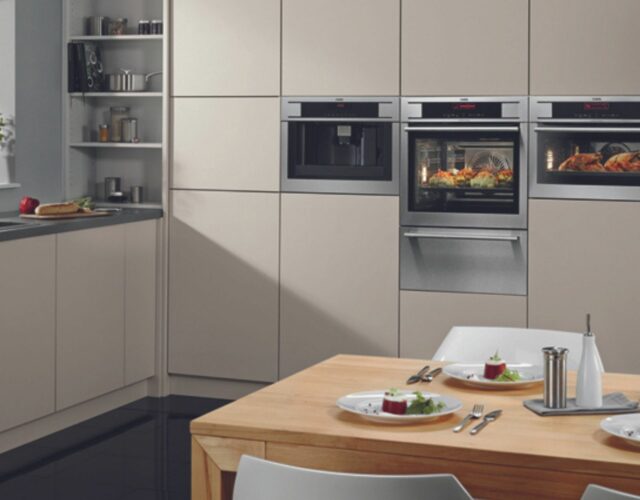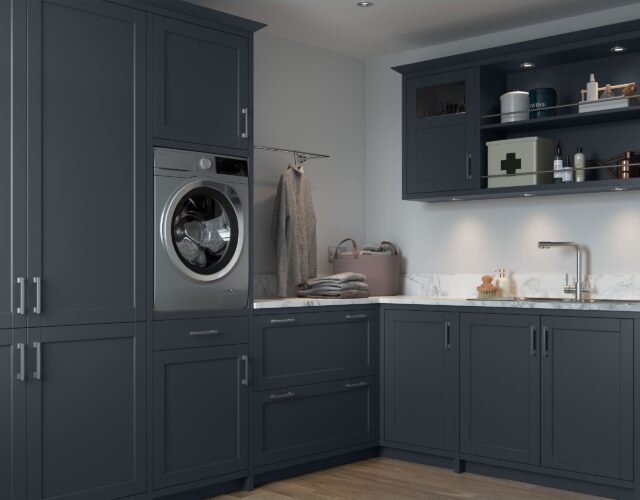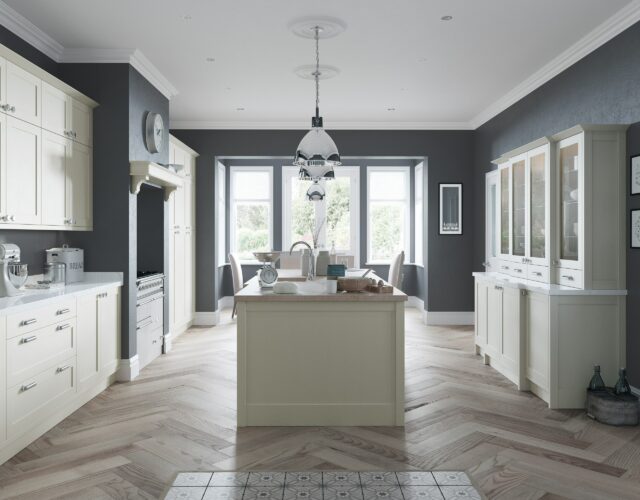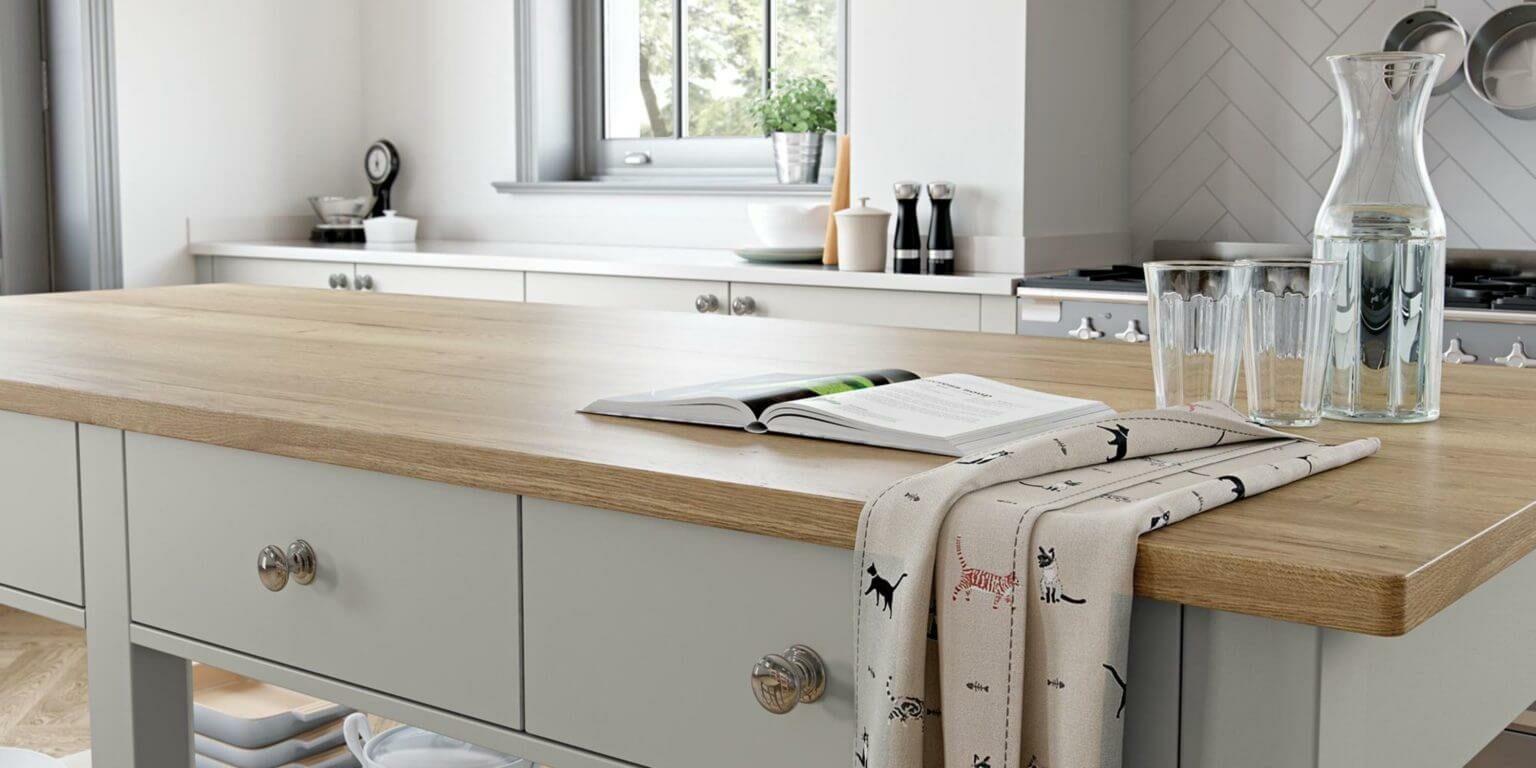

By Lara
A Guide To Choosing Kitchen Worktops
How To Choose The Best Kitchen Worktop For Your Home
Our kitchen specialists at Ream Interiors have put together this helpful guide to assist you in deciding which worktops you may want to consider in your new kitchen. It is important your worktop meets your requirements in both style and budget, weighing up the pros and cons of each material dependent on your lifestyle and needs. First, we have detailed some initial factors that may impact the worktop materials you choose to consider. Next, we’ll talk you through a more detailed breakdown of the pros and cons of some of our most popular worktops, pointing you in the right direction and giving you a well-rounded view of what worktops may be best for your individual needs.
If you’ve already got a particular worktop in mind and you’d like to find out more about whether it will be suitable for your space you can follow the below shortcuts to learn about the specific considerations of the individual material. Below are the work surfaces we are going to take a closer look at in this article:
- Laminate
- Wood
- Compact Laminate/Solid Core Laminate
- Composite Stone
- Natural Granite
- Acrylic Coated
What To Consider When Choosing Your Worktop?
Budget
There are a range of wonderful materials on offer to suit any budget. Advancements in modern technology have improved the capabilities of many products, meaning there is now a much wider variety of choice than there has been in the past. At the lower end of the scale you may want to consider laminate, wood, solid core/compact laminate or a solid surface acrylic. More expensive worktop materials include granite, marble, composite stone, glass, ceramic, concrete and acrylic coated.
Maintenance
Some worktops will require a certain amount of care to keep them in pristine condition, which can be inconvenient and poses an additional cost of both time and money. Materials that require some levels of maintenance include natural woods, acrylic coated worktops and natural, uncoated stones such as granite.
Durability
If you’re a keen cook, the longevity and lifespan of your worktops is going to be an important factor when it comes to deciding on your perfect worktop. Harder stone worktops tend to have good scratch resistance, but some have the tendency to chip and stain, and some composite materials can also be affected by heat. Some of the most durable work surfaces lie in good quality laminates, composite materials, granite and stainless steel.
Style
Different worktops will come in different choices of finish, thickness and colour. Further to this, some methods of installation can create unsightly joints. For the greatest range of styles consider composite stone or granite. Most composite and natural stone materials will require a ‘template and fit’ process, leaving a sleek finish without joints. However, this can increase the price and time it takes to install.
What Are The Different Types Of Kitchen Worktops?
Laminate Worktops
Laminate worktops are made by pressure sealing a laminate overlay onto a composite fibreboard or chipboard sheet. There are HPL’s, which are high pressured laminates and LPL’s (melamine) which are low pressured laminates. Laminate has been on the market for a very long time, leading some people to characterise it as unattractive and poor quality, however recent advancements mean there are now lots of different brands and qualities available, some of which provide excellent value for money.
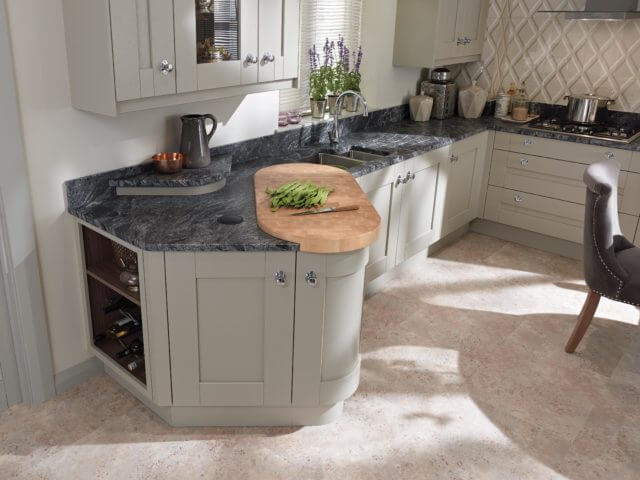
Benefits Of Laminate Kitchen Worktops
Laminate comes in a wide range of colours and finishes including gloss, matt and textured. A good quality laminate is highly durable, maintenance-free and offers flexible installation. With lengths of 3m and 4m frequently available, a design with less joins can be easily achieved. When joined skilfully, the imperfection will be less visible than with solid surfaces.
Considerations
Unfortunately, the quality and finish of laminate worktops can vary across brands, which is something to watch out for on your hunt for the perfect worktop solution.
Gloss finish laminates are easily scratched and have poor heat resilience, making them easy to damage. A gloss finish tends to look artificial and sometimes unappealing.
However, as mentioned above, many laminates are highly successful. A good indicator of a laminate’s quality is the waterproofing design located on the underside of the worktop. A sealed strip should protect the composite from moisture, and without this strip, any liquid will be absorbed, warping the laminate and causing it to ‘blow’ (an industry term for when water causes the material underneath to swell and break through the laminate).
Wood Worktops
Wooden worktops are formed using strips of wood called staves, which are glued together to form lengths of worktop, giving stability and preventing the wood from warping. Wood is a popular choice for its wonderful aesthetic attributes. The multiple stave construction creates an attractive pattern whilst warm wood tones give an authentic and natural look. The grain brings a beautiful, textural finish.
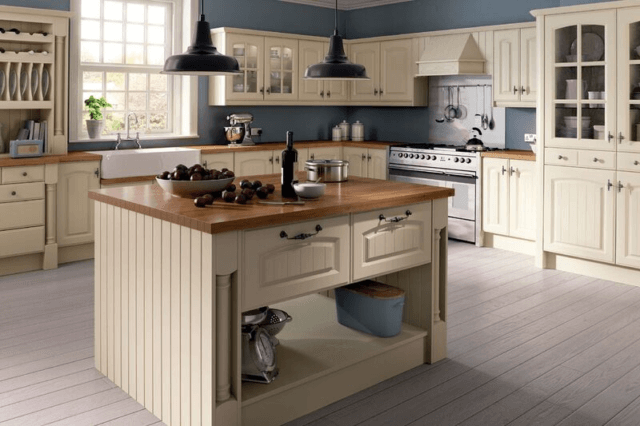
Benefits Of Wooden Kitchen Worktops
The primary benefit of a timber worktop is its looks. When maintained they appear warm, inviting and luxurious.
Depending on the type of wood they are also generally affordable.
Timber work surfaces are usually cut and fitted on location for efficient installation, but unlike laminate they offer a broad range of design options such as under-mounted sinks, drainage grooves and curved detailing at a cost considerably lower than it would be in solid surfaces.
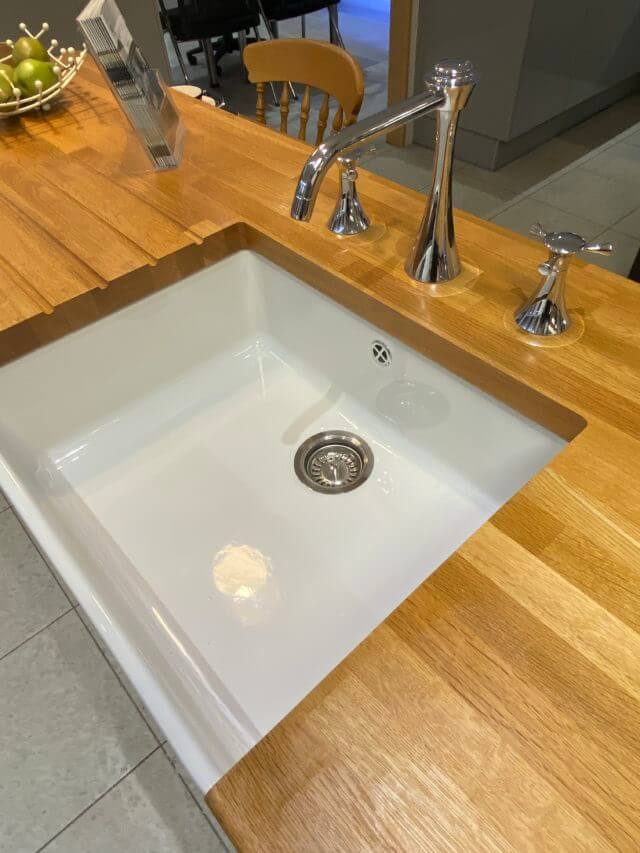
Considerations
Wooden work surfaces require an extremely high level of care and maintenance. They must be sanded and oiled regularly (exactly how often is dependent on individual care recommendations). If they are not properly treated they may crack, stain, warp and blacken. Some woods are also very soft and easily scratched.
Heat tolerance is poor, and you will need to use heat protection such as rubber mats or metal trivets for pots and pans to avoid burning the surface.
One of the biggest issues with timber work surfaces is their intolerance to water. Areas around sinks and taps can easily become black if not monitored and treated as needed. Bacteria can gather in marked or scratched areas which, if not properly cleaned, can pose a risk to hygiene.
But for all the drawbacks of a wooden work surface, let’s not forget the beautiful and characterful aesthetic. Some of the most welcoming country kitchens are finished with a chunky wooden worktop, and there’s nothing quite like it for creating that homely feeling.
Compact/Solid Core Laminate Worktops
Numerous sheets of resin soaked paper are compressed and then dried between decorative laminate layers. A relatively new product, this type of laminate has been technologically enhanced to boost durability and practicality.
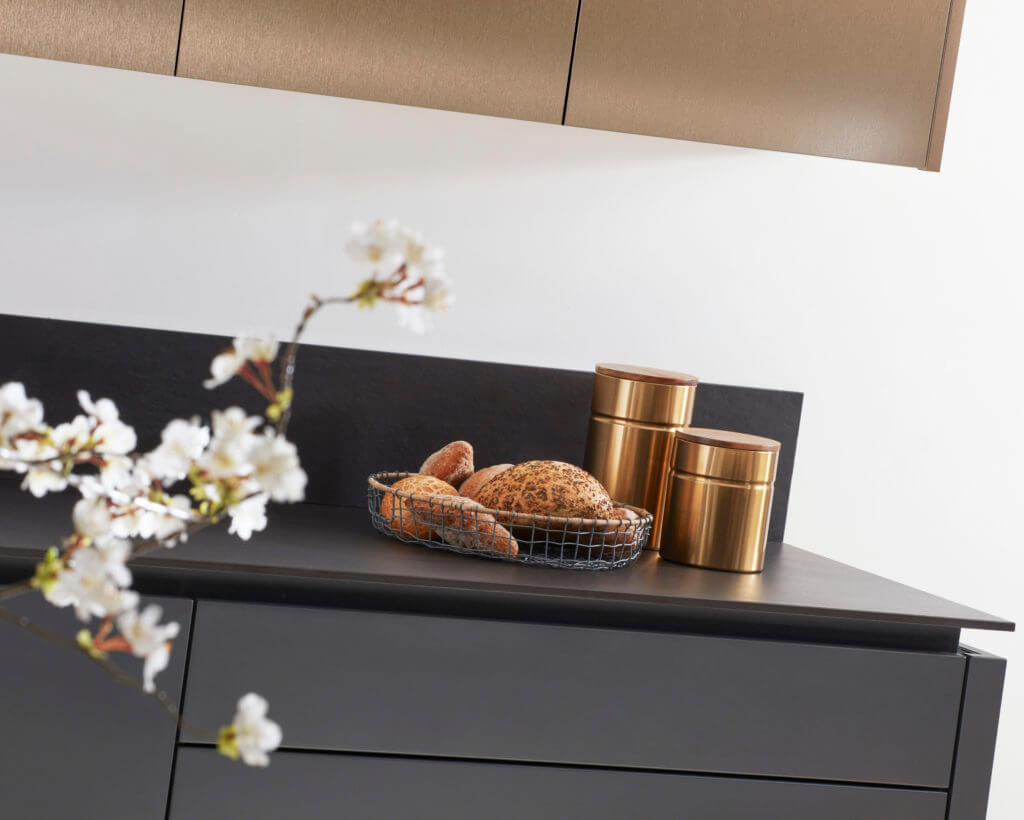
Benefits Of Compact & Solid Core Kitchen Worktops
The durability of this material rivals that of composite stone. It boasts the advantages of being waterproof, stain-resistant, hard-wearing and hygienic.
Edging does not need to be applied as with normal laminate, giving a simple and more flexible range of installations.
Considerations
Compact worktops are only available in 12mm thickness, which can create design limitations, particularly around installing a hob. The base of the hob will sit lower than the depth of the worktop meaning the space below is restricted, it is not possible to install a drawer for example.
Depending on which brand you consider there are sometimes colour choice limitations, As well as this, the edge colour is restricted to solid colours such as white, black, grey & beige, none of which will match the colour of the tops.
Limited sizes are available which could potentially affect the design layout or create wastage upon installation.
This product must be fitted by a technician trained in solid core laminate installation as specialist biscuit joints require specific tools and a thorough knowledge of the product.
Composite Stone Worktops
Composite stone is a man-made material using 80-90% natural quartz or granite that is granulated (mixed) with 10-20% resin and subsequently reformed into slabs for your worktop. Often referred to as quartz, for many years this has been one of the most popular solid surface options. This material is supplied by a range of top worktop brands including Silestone, Caesarstone, Cambria and Okite.
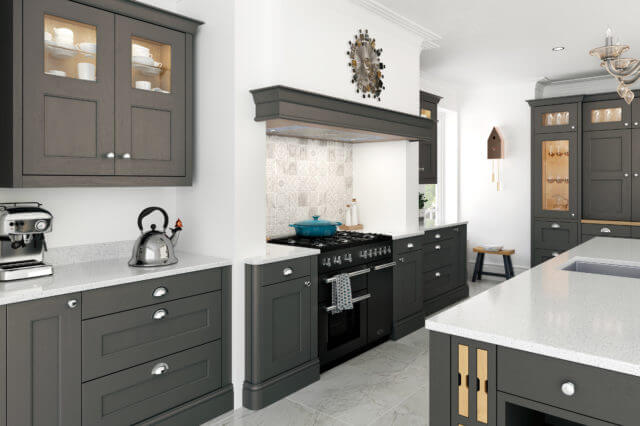
Benefits Of Composite Stone Kitchen Worktops
Composite stone comes in a beautiful range of finishes and styles including gloss, matt and textured. Some composite stone worktops have a ‘sparkled’ appearance, which is a popular choice for a modern kitchen. There is also an option for a pure white marble effect, providing an elegant alternative to natural marble.
Adding resin to the natural stone dramatically increases the material’s stain-resistance and prevents the need for ongoing maintenance. Though highly resilient, harsh substances like coffee or turmeric can stain if not cleaned up promptly.
Considerations
As a type of solid surface worktop, composite stone requires a ‘templating and prefabrication’ fitting service. This is where the stone company will come to your home to measure for the worktops after the kitchen units have been put in. They then take the measurements (templates) away and produce the worktops on their factory machinery. The time between templating and fitting can take anywhere between 5-10 working days.
Although an extremely durable material, composite stone can still accidentally be scratched or chipped.
Composite stone is generally heat tolerant to 120 degrees. Past this temperature the resin can degrade, so although the stone can handle some heat it is advisable to exercise caution and use heat protective mats and trivets when necessary.
Natural Granite Worktops
Mined globally, granite is cut into slabs and used in its natural form, with no artificial interference. Arguably one of the most beautiful worktops available, natural granite also has the greatest diversity of colours.
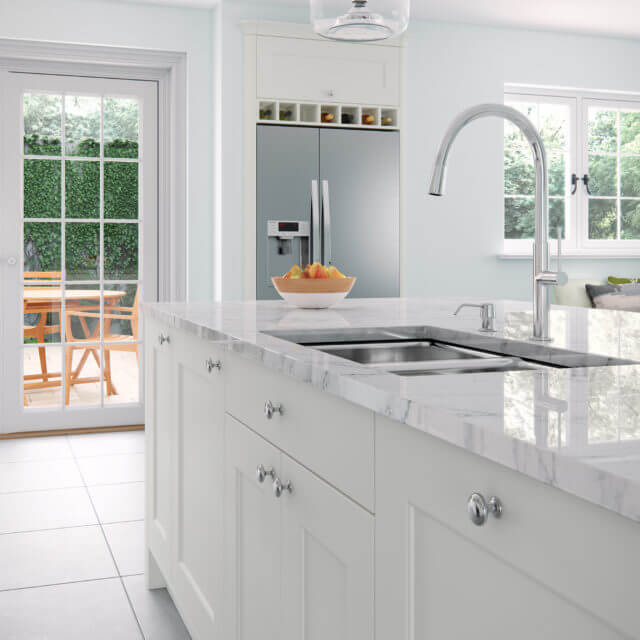
Benefits Of Natural Granite Kitchen Worktops
The biggest appeal of natural granite is its beauty. The visible crystals in the surface are stunning, creating remarkable depth and movement. Each slab is totally different, and each owner of a granite worktop has a unique, individual piece in their possession.
Considerations
The greatest disadvantage of natural granite is its porosity, meaning it has a tendency to draw in liquids and stain. Generally, the lighter the colour the more likely it is to absorb substances, thus causing visible staining. Some black granites are in fact very resilient to staining, but these tend to be more solid, flat coloured granites, such as ‘Nero Assoluto’ which are less popular for their appearance. Granite also offers a more glossy surface compared to a quartz worktop which is of a duller finish.
The ongoing maintenance refers to the need to re-seal every 6 months to a year (dependent on which granite you have). This is not a difficult task, but for some it can be an inconvenience. Resealing does not completely prevent staining, but it does help. Products like lemon juice, oil, red wine and turmeric will still need to be wiped up very quickly. It is worth noting that some of these stains can be removed at a cost by a stone company.
Granite has a high heat tolerance, however instant direct heat can potentially ‘thermo-shock’ the granite and cause a crack, thus it is recommended to still use heat protection. Granite has a heat resistance of up to 150 degrees.
All solid surface worktops have the potential to accidentally chip, however this can be repaired. The work is less obvious than in composite stone, as natural variations from the crystals in the granite’s structure disguise any imperfections.
Like composite stone, granite also requires ‘templating and prefabrication’, resulting in a longer installation time.
Acrylic Coated Worktops
Acrylic coated worktops are manufactured similarly to composite quartz, however the quantities and products used are very different. Corian is a blend of 33% acrylic polymers and 67% natural minerals. Produced in 12mm sheets, these are then fixed onto a chipboard or MDF base to build up the thickness, similar to laminate.
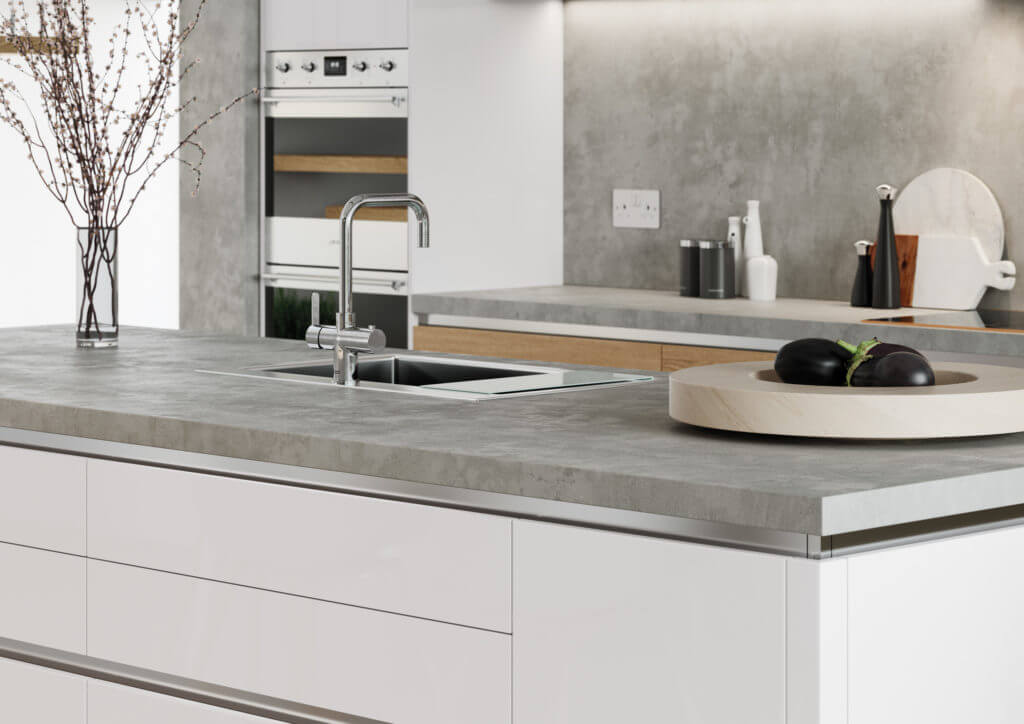
Benefits Of Acrylic Kitchen Worktops
Acrylic coated surfaces offer incredible design flexibility. They can be ‘thermo-formed’ (heated and manipulated into shape) into a variety of unusual structures for a unique design. ‘Moulded’ sinks are particularly popular, creating a seamless transition from the worktop into the basin. Thermo-forming also eliminates the need for unsightly joins for a sleek and attractive design.
Another benefit of acrylic surfaces is their inability to stain.
Considerations
Acrylic coated worktops can be one of the more expensive options available, so understanding the restrictions of the product is important.
The high resin content means the surface is very soft and easily scratched. Severe tarnishes can harbour bacteria and allow stains to penetrate. This makes its necessary to carry out regular maintenance to repair the surface and buff out the scratches. This is easy to do and allows for an ongoing high finish, however it may be considered inconvenient. The softness of the material also limits you to just one matt finish which may not suit your taste.
Acrylic has a heat limit of 100 degrees Celsius, putting a hot pan down could easily melt the surface. Likewise, boiling water could damage a ‘moulded’ sink. A boiling water tap would be unadvisable unless you fit a stainless-steel base, though this would detract from the smooth aesthetic.
Hopefully, this guide has improved your understanding of the worktop materials available, helping you to narrow down some options you may want to consider in your beautiful new kitchen. However, with so many different properties and styles to think about it may still feel like an overwhelming choice. If you have a competent and knowledgeable kitchen designer working with you, they will be trained to listen to your personal situation to advise on the best solution for you. We are here 6 days a week helping locals in Kent. From Maidstone to Faversham and out to Gravesend and Rainham, call us today to get some advice.
Alternatively, if you are pursuing a project by yourself the task may fall solely on you to research, choose and source your own work surfaces. Weighing up all the pros and restrictions of each material is critical to ensure you select a product that meets your expectations.


